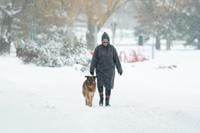Thousands of homes remained without power into Thursday after a major storm swept powerful wind gusts through parts of southwestern Ontario, toppling trees onto houses and wreaking widespread damage on power lines.
Hydro One reported power outages for more than 7,000 customers as of 1:30 p.m. Thursday concentrated around the hard-hit regions of Essex County and Chatham-Kent.
Mary Ann Rampersaud said she witnessed some of the worst damage in the small community of Harrow, where the storm passed through with astonishing speed and intensity.
"There was nothing, and then all of a sudden there was a huge wind, tons of rain and everything was just down," said Rampersaud, who had set out from her home in nearby Amherstburg as the storm approached.
Environment Canada reports wind gusts topped 90 kilometres an hour and dumped around 15 millimeters of rain on Harrow around 4 p.m. Wednesday during the storm's peak. Tornado warnings and watches blanketed much of the region at the time.
Rampersaud said she saw a mess of debris in the storm's wake, adding that other residents also told her of the swift damage they saw.
"They're like, we blinked and we looked outside and it was like a whole different world and landscape," she said.
Essex County said multiple tree branches and powerlines had been knocked down, blocking roadways in a number of spots in Harrow and Colchester South.
A team of tornado researchers out of Western University were expected to survey the area Thursday morning.
Southwestern Ontario has withstood a number of extreme weather events this summer. Just last week, two tornadoes hit the South Buxton and Petrolia areas, marshalling estimated maximum wind speeds of 175 kilometres an hour, according to researchers with the Northern Tornadoes Project at Western University.
A growing body of evidence in the U.S. indicates tornadoes are moving eastward from so-called Tornado Alley in the prairies to more densely populated regions, researchers say.
Part of the Northern Tornadoes Project's mission, as it builds out a massive database of weather events, is to find out whether the trend also extends to Canada, lead researcher Gregory Kopp said in a recent Western University blog post.
The recent spate of storms, Rampersaud said, has served as an important emergency preparedness reminder.
"It's a good cautionary tale," she said. "You never think it's going to happen, but sometimes it does."
This report by 香港六合彩挂牌资料 was first published July 27, 2023.












































